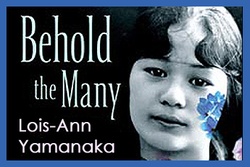In 1913 Hawai‘i, three young sisters suffering from tuberculosis are sent to an orphanage. Only one survives—and she finds herself haunted by the ghosts of her siblings.
In her novel Behold the Many, author Lois-Ann Yamanaka employs an evocative variety of character voices to convey a tale of remorse, abandonment, and family curses.
“I don’t know if this is so much a ghost story as a story with ghosts in it,” Yamanaka says. “There are many other threads in the novel and the story of the ghosts is one of these threads. It is truly a story inspired by the ghosts of the three girls to whom I dedicate the book. But is it a ghost story? I don't know.”
For Yamanaka, whose lyrical use of Hawai‘ian dialects has drawn critical acclaim, the eerily compelling novel represents a step further into different territory.
“I think my writing has gotten darker and darker as I try to work out my thoughts and feelings about events in the world or in my life,” the Moloka‘i-born author says. “My editor on all my adult novels, John Glusman, taught me how to be a novelist and his influence is reflected in each book I write. I think I am always trying something new with regard to narrative structure or voice or my language on the page.”
Woven into the pages of Behold the Many are complex themes and painful paradoxes of human emotion.
“The story explores how love can be as strangulating as it is freeing, and how in love we tend to hold on in ways that can hurt,” Yamanaka explains.
“There is also the notion of ‘home,’ which is a thread that keeps appearing in each of my novels,” Yamanaka adds, noting that the fear of separation is especially powerful in children. “The little girls’ spirits got confused when the girls died. They thought they were going home to the plantation but didn’t realize they were supposed to now go ‘home’ to God. This confusion leaves them trapped, waiting for Mommy and Daddy to come and get them as they had promised when the girls were left in the care of the nuns. However, no one is coming, and it is an eternity before they actually go ‘home’.”
While ghostly spirits inhabit Yamanaka’s novel, they are not the only invisible presence in the book. The inspiration of fellow authors is also a force that continually guides Yamanaka’s writing.
“Each book I write is surrounded by a constellation of writers,” Yamanaka says. “For Saturday Night at the Pahala Theatre it was Jessica Hagedorn, Sonia Sanchez, Lucille Clifton and Darrell H.Y. Lum. ForBehold the Many, I read William Faulkner—who blew me away. Cold Mountain by Charles Frazier, Empress Orchid by Anchee Min and Music and Silence by Rose Tremain which I loved. There are many others. Some I discover during the loads of research.”
While Yamanaka enthuses about the art of writing, she admits concern about the occasional debates sparked by her use of pidgin (a dialect spoken by many Hawai‘ians), graphic language, and sometimes controversial ethnic characters.
“In Hawai‘i, we are in our adolescence with regard to literature—we have many more pimples and proms to come,” Yamanaka says. “I think, though, that we have a tendency toward the crab-in-the-bucket kind of behavior rather than encouraging all voices to speak their stories and poems. Not to change metaphors, but we need to keep adding spokes to the wheel to move forward, not pluck spokes off the wheel. I went through a period where I felt the critics/academics inside my writing space looking over my shoulder.”
But whether grappling with the specter of self-censorship or probing the haunting depths of her characters’ psyches, Yamanaka remains passionate about America’s 50th state and its fertile ground for storytelling.
“In spite of urbanization and technology, spirituality in all of its manifestations permeates our lives here in the islands,” says Yamanaka. “What hasn’t changed is the way rocks still hold essential power in places. How spiritual beliefs and practices are still an important part of beginnings and endings. And how the seen and unseen still inhabit this place with a kind of generational respect.”
* This article was originally published on the Japanese American National Museum Store Online in February 2006.
© 2006 Japanese American National Museum







